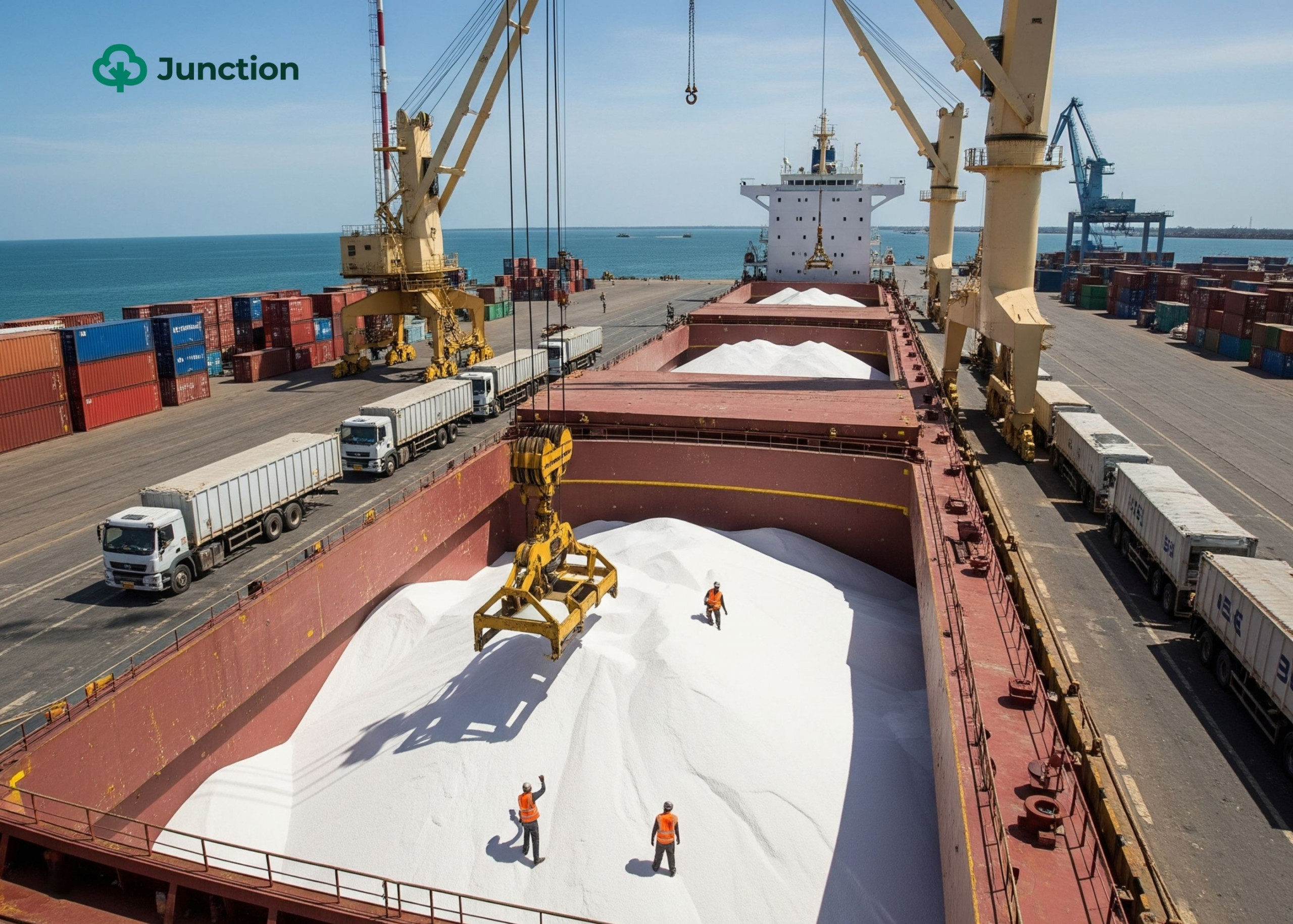Questions answered in this article:
– What is the current state of irrigation in Nigeria and how does this negatively impact food production?
– How can improved irrigation systems increase Nigeria’s food production and food security?
– What is the correlation between irrigation, mechanisation and increased food production?
What 2030 can look like in Nigeria’s agriculture
This is 2030 and Nigeria has a lot to celebrate. Through the sheer will of policy makers, innovative and bold thinking, Nigeria has solved its once pressing issues of food security, food import substitution, the fear and potential of its youths turning to crime because of unemployment; and ultimately, the slow economic development that it faced 10 years ago.
In 2024, Nigeria decided to take agriculture more seriously and tackled the problem of single cycle farming by approaching irrigation and mechanisation through an innovative system that brought private sector and public sector funds together to support agriculture both strategically-for long term gains and tactically-for short term gains. In the 5 years from 2025 to 2030, it transformed its irrigable and mechanised cultivated land holding from 290 thousand hectares to 5 million hectares that is still steadily growing annually.
Today, Nigeria produces about 82 million tons of grains on over 5 million hectares of private sector managed, irrigated, and mechanised land, that is making over $24 billion in farm gate value and $200 billion through the value chain. With the same transformation effort that started in 2024, Nigeria has also created over 2 million jobs by being a dominant player in the $1 billion African food market, and it is once again a major force to reckon with in global agricultural production and food supply.
Now back to present reality
According to the Food and Agricultural Organization (FAO), even though agriculture still remains the largest sector of the Nigerian economy and employs two-thirds of the entire labour force, production hurdles have significantly stifled the sector’s performance. Food (crop) production increases have not kept pace with population growth, resulting in rising food imports and declining levels of national food self-sufficiency. The main factors undermining production include reliance on rainfed agriculture, smallholder land holding, and low productivity due to poor planting materials, low fertiliser application, and a weak agricultural extension system, amongst others.
Nigeria’s agricultural productivity situation is such that less than 30% of its cultivated land’s production capacity is realised —because of annual single cycle rainfed farming, that is a result of inadequate, poorly managed and inaccessible irrigation. To put this in context, Nigeria only irrigates about 290 thousand hectares, which is about 0.3% of its agricultural land. The result of which is that average annual productivity of cereal crops such as rice, per hectare of land is a dismal 1.2 tons compared to Vietnam’s which stands at 16.5 tons per hectare annually. Note that Vietnam has similar socio-economic indices as Nigeria, 20% of Nigeria’s cultivated land but irrigates over 66% of it.

If irrigation and mechanisation are improved, the future of Nigeria’s agriculture holds promise with a potential of up to 15 times productivity gains. For example, 1 million hectares of irrigable land will produce about 17 million tons of rice paddy per annum, which is nearly double the 8.5 million tons produced today on more than 4 million hectares of land.
Even though Nigeria’s public and private sector players continue to push towards bridging the home-grown food supply gap, unfortunately, the impact is not resonating enough as fundamentals such as irrigation and mechanisation are lacking.
Therefore, to improve production, irrigation has to be transformed within the broader context of mechanisation. In the face of limited government funds chasing a myriad of urgent issues, it has now become important for policy makers to explore new and innovative ways of solving and funding solutions to low productivity in Nigeria’s agriculture that is caused by inadequate irrigation and mechanisation.
There is new thinking in a Public, Private and People Partnership (PPPP) model that fosters collaboration for the funding and transformation of irrigation, mechanisation and ultimately agricultural production in Nigeria. This will entail galvanising both tested and new models, competencies and capacity to create a holistic approach, the impact of which will be greater than the sum of its parts.
We are leaving our food on the table
Because of reliance on rain fed farming, the vast majority of smallholder farmers (over 95%), that constitutes 70% of Nigeria’s food production capacity, are only able to produce in a single farming cycle out of a possible three to four farming cycles per year. This represents a paltry one quarter capacity utilisation of their most important agricultural asset —land. Furthermore, because agricultural production growth is a factor of either yield per hectare or land capacity usage, this situation diminishes the earning potential of the smallholder farmer and hinders the actualisation of Nigeria’s total agricultural productivity potential.

When the effect of inadequate irrigation cascades downstream the value chain and ultimately to the retail market, staple cereal production in one farming cycle translates to 3- 4 months of production out of a possible 12 months, leaving about 8 months of inactivity to wide variations and fluctuations in produce availability and pricing. This encourages speculation, and further transfers low capacity utilisation downstream the value chain to the processing and milling industries. Ultimately, the country resorts to food importation which distorts economic indices such as food prices and applies attendant pressure on the Naira.
Nigeria has long identified the need to support year-round crop production, and in the 1970s through the 1980s, concerted efforts were made to provide dams and other irrigation infrastructure that are nonetheless currently inadequate. Out of the 36 million hectares of arable land available in Nigeria, only 6.5 million hectares are under permanent cultivation, and about 293 thousand hectares are irrigated. Nigeria’s irrigated land translates to a paltry 0.9% of cultivated land and 0.3% of total arable land, that are mostly served by the about 17 active dams owned by the Federal and State Governments —all of which are currently operating at suboptimal levels and with little access by smallholder farmers.

Nigeria will not reach its homegrown food security potential and seize its food export opportunity by relying mostly on rainfed farming as even outside year-round farming, relying solely on rain during raining season does not provide adequate water for optimal yields. The latest science and research development support irrigation as best practice for optimal yield in and out of the raining season.
New thinking, bold ideas, improved farmers’ profiles and technologies must be applied to achieve irrigation and year-round farming. Most importantly, the private sector and young people must be involved to achieve efficiency, effectiveness and an explosion of innovation.

A new approach to productivity: Irrigation of contiguous clustered land
Nigeria’s agricultural production will improve if concerted effort is directed towards delivering well-structured and -managed medium to long term capability and capacity for irrigation fed year-round farming on contiguous clustered land.
Solving the challenge of inadequate irrigation will bring about unrestricted farming cycles and anytime/every time production. Currently, farmers have to align their cropping calendar to the rain cycles, which has to be done with precision for best results. Unfortunately, and oftentimes, precision is unachievable as other factors of production such as input or funds are not obtained in good time. Usually, a lot of farmers miss perfect timing to the rain cycles for best results, or miss the raining cycle completely, which makes them unproductive for up to a year in some instances. If irrigation is implemented, farming can start anytime, and farmers can get right into production when they are ready and able, without waiting for the rains.
Where mechanisation is a natural linear addition
It is obvious that success scored by irrigation on contiguous clustered land can be further enhanced if mechanisation is improved and mainstreamed to enable farmers carry out land preparation, harvesting and transportation, timely and efficiently. Nigeria has a dismal tractor horsepower density ratio of 0.27 against the FAO’s minimum standard of 1.5. This means that for every 1,000 hectares, Nigeria has only 27 horsepower of tractors against a minimum requirement of 150. Improved mechanisation will be a natural linear addition to irrigation on contiguous clustered land. It is possible and economically efficient to implement irrigation and mechanisation with the same group of efforts, management and service business model. It is also instructive that concurrently solving issues around irrigation and mechanisation will further improve productivity in Nigeria’s agriculture as shown in Tables 1 earlier, the table and Chart 2 below:


Engaging a collaboration of public and private players for the funding, implementation and management of irrigated and mechanised land in contiguous clusters will solve the problems plaguing the existing fragmented tube well system and deliver exponential results, while creating a new crop of empowered farmers in a short period. This model will galvanise the efforts and resources of the Public sector; Private sector and the People in a Partnership (PPPP). It will create well defined responsibilities for each player in the collaboration, create ample opportunities for impressive return on investment; support the deployment of strong management and governance practices and derive effectiveness and efficiency from private sector participation.

A blended financing model where the syndication of two categories of entities will provide two distinct categories of financing, with each category of entities focusing on either long term or short-term finance elements.
Economics of the new approach
With this model, it is possible to repay capital expenditures (CAPEX) investment for irrigation, mechanisation, and infrastructure development in less than 10 years, assuming at an interest rate of 5% per annum and approximately 21% of annual revenue is allocated to repayment.
Scenarios of percentages and absolute values have been modelled to highlight returns to all categories of players in the model.

Scenario analysis: percentage contribution of funding category and share of total revenue. Absolute values of funding and share of total revenue.
Assumptions: Base case scenario of 5 tons/hectare/cycle in 3 production cycles per annum.
Interest rate of 5% per annum.
Sustainability and continuous momentum
Organised private sector participation in agriculture, spurred by improved delivery of fundamentals such as land, irrigation and mechanisation in contiguous clusters will improve investment in agriculture. Private sector funds will be confident enough to join, and ultimately take over from public sector investment in long term infrastructures of land, irrigation, and mechanisation.
Financial institution credit to agriculture will also grow from about 3.36% of total credit to the private sector to about 25%. This will be the perfect picture of success of public sector intervention in catalysing agricultural development in Nigeria, and we believe the PPPP model will deliver it.
Conclusion
There has been no such time as important at this to create a lasting impact and legacy in improving Nigeria’s agricultural productivity, as the 2 pronged and interdependent challenges of food insecurity and youth unemployment facing us-that agriculture can solve require bold ideas and innovation.
A new inclusive model for irrigation and mechanisation that democratises access for farmers provides an opportunity to change for the better, how things are done in Nigeria’s agriculture and potentially that of the whole of Africa.




I cannot believe how poor our irrigation capacity is and I don’t even want to think of how badly efficiency is faring.